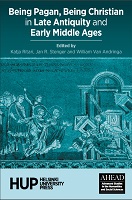Being Pagan, Being Christian in Late Antiquity and Early Middle Ages
Contributor(s)
Ritari, Katja (editor)
Stenger, Jan (editor)
Van Andringa, William (editor)
Language
EnglishAbstract
What does it mean to identify oneself as pagan or Christian in Late Antiquity and the Early Middle Ages? How are religious identities constructed, negotiated, and represented in oral and written discourse? How is identity performed in rituals, how is it visible in material remains?
Antiquity and the Middle Ages are usually regarded as two separate fields of scholarship. However, the period between the fourth and tenth centuries remains a time of transformations in which the process of religious change and identity building reached beyond the chronological boundary and the Roman, the Christian and ‘the barbarian’ traditions were merged in multiple ways.
Being Pagan, Being Christian in Late Antiquity and Early Middle Ages brings together researchers from various fields, including archaeology, history, classical studies, and theology, to enhance discussion of this period of change as one continuum across the artificial borders of the different scholarly disciplines. With new archaeological data and contributions from scholars specializing on both textual and material remains, these different fields of study shed light on how religious identities of the people of the past are defined and identified.
The contributions reassess the interplay of diversity and homogenising tendencies in a shifting religious landscape. Beyond the diversity of traditions, this book highlights the growing capacity of Christianity to hold together, under its control, the different dimensions – identity, cultural, ethical and emotional – of individual and collective religious experience.


 Download
Download Web Shop
Web Shop